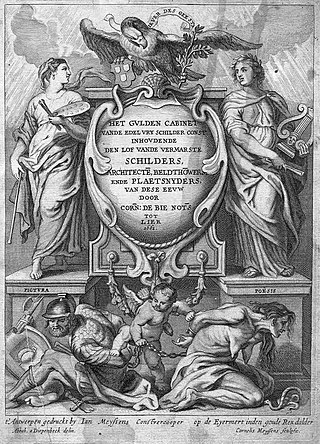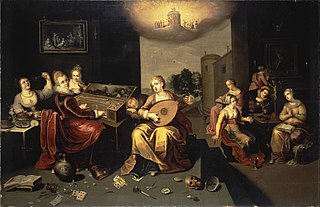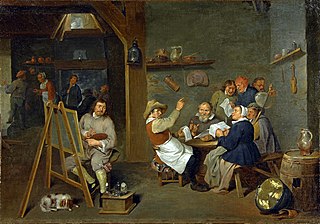Related Research Articles

David Teniers the Younger or David Teniers II was a Flemish Baroque painter, printmaker, draughtsman, miniaturist painter, staffage painter, copyist and art curator. He was an extremely versatile artist known for his prolific output. He was an innovator in a wide range of genres such as history painting, genre painting, landscape painting, portrait and still life. He is now best remembered as the leading Flemish genre painter of his day. Teniers is particularly known for developing the peasant genre, the tavern scene, pictures of collections and scenes with alchemists and physicians.

Gonzales Coques was a Flemish painter of portraits and history paintings. Because of his artistic proximity to and emulation with Anthony van Dyck he received the nickname de kleine van Dyck. Coques was also active as an art dealer.

Genre painting, a form of genre art, depicts aspects of everyday life by portraying ordinary people engaged in common activities. One common definition of a genre scene is that it shows figures to whom no identity can be attached either individually or collectively, thus distinguishing it from history paintings and portraits. A work would often be considered as a genre work even if it could be shown that the artist had used a known person—a member of his family, say—as a model. In this case it would depend on whether the work was likely to have been intended by the artist to be perceived as a portrait—sometimes a subjective question. The depictions can be realistic, imagined, or romanticized by the artist. Because of their familiar and frequently sentimental subject matter, genre paintings have often proven popular with the bourgeoisie, or middle class.
David Rijckaert or Ryckaert may refer to any of these Flemish painters active in Antwerp in the 17th century:

David Ryckaert III, David Rijckaert III or David Rijckaert the Younger was a Flemish painter known for his contribution to genre painting, in particular through his scenes of merry companies and peasants. He also painted hell scenes and images of alchemists. He enjoyed the patronage of prominent patrons and was a painter to the court of the governor of the Southern Netherlands.

Marten Ryckaert or Maerten Ryckaert, was a Flemish landscape painter. He was known for his small, usually imaginary landscapes in an Italianate style.

Flemish Baroque painting was a style of painting in the Southern Netherlands during Spanish control in the 16th and 17th centuries. The period roughly begins when the Dutch Republic was split from the Habsburg Spain regions to the south with the Spanish recapturing of Antwerp in 1585 and goes until about 1700, when Spanish Habsburg authority ended with the death of King Charles II. Antwerp, home to the prominent artists Peter Paul Rubens, Anthony van Dyck, and Jacob Jordaens, was the artistic nexus, while other notable cities include Brussels and Ghent.

Frans Francken the Younger was a Flemish painter and the best-known and most prolific member of the large Francken family of artists. He painted large altarpieces for churches as well as smaller historical, mythological and allegorical scenes. His depictions of collectors' cabinets established a popular new genre of art in the era. Francken often collaborated with other artists, adding figures and narrative elements to scenes created by specialists in landscape, architectural and floral still life paintings.
Events from the year 1587 in art.

Thomas van Apshoven was a Flemish painter known for his landscapes with peasant scenes and genre scenes in interiors. His genre scenes depict village festivals, the interiors of taverns, village scenes or landscapes with peasants engaged in various activities, singeries, guardroom scenes and laboratories of alchemists. Some still lifes have also been attributed to him. His themes and style are close to that of David Teniers the Younger.

Het Gulden Cabinet vande Edel Vry Schilder-Const or The Golden Cabinet of the Noble Liberal Art of Painting is a book by the 17th-century Flemish notary and rederijker Cornelis de Bie published in Antwerp. Written in the Dutch language, it contains artist biographies and panegyrics with engraved portraits of 16th- and 17th-century artists, predominantly from the Habsburg Netherlands. The work is a very important source of information on the artists it describes. It formed the principal source of information for later art historians such as Arnold Houbraken and Jacob Campo Weyerman. It was published in 1662, although the work also mentions 1661 as date of publication.

Pieter van Bredael or Peeter van Bredael (1629–1719) was a Flemish painter specializing in market scenes and village feasts set in Italianate landscapes or contemporary, usually, urban environments.

Jacob Denys or Jacob Denys (II) (1644–1708) was a Flemish Baroque painter. His known works are mainly portraits. He also painted landscapes and history paintings. After training in Antwerp, he worked for a long time in Italy where he enjoyed the patronage of Duke of Mantua, Ferdinando Gonzaga, and the Duke of Tuscany, Cosimo III de' Medici.

Jan Baptist Bosschaert or Jan Baptist Bosschaert the Younger was a Flemish still life painter who is principally known for his decorative still lifes with flowers. He collaborated with figure artists on compositions which combined allegorical or mythological scenes with a still life element. He was active in Antwerp.

Gaspar Peeter Verbruggen or Gasparo Pedro Verbruggen was a Flemish still life painter who is principally known for his decorative still lifes with flowers and fruit. He collaborated with figure artists on compositions which combined figures with a still life element. He was active in Antwerp and The Hague.

Johannes Ykens, was a Flemish Baroque painter and wood sculptor. He is known for his Christian religious scene, history paintings and portraits and his sculptures for churches.

Hieronymus Francken the Younger or Hieronymus II was a Flemish painter and one of the most prominent members of the large Francken family of artists. Along with his brother Frans Francken II he played an important role in the development of new genres in Flemish art in the early 17th century. He was a prolific artist with a wide range who painted religious scenes, allegorical subjects, portraits, fruit pieces, genre scenes, architectural paintings and art galleries.

Mattheus van Helmont was a Flemish painter specialized in genre scenes of interiors and village scenes. His style and subject matter were influenced by the work of David Teniers the Younger and Adriaen Brouwer. His preferred subjects were peasant feasts, wedding celebrations, drinkers and alchemists. He developed his own personal style towards the final phase of his career. He spent most of his active life in Antwerp but moved to Brussels later.

Erasmus de Bie (1629–1675) was a Flemish Baroque painter known for his city views and genre scenes. He depicted several lively scenes of large public celebrations in his hometown of Antwerp. It is not clear whether the views of Italianate cities and landscapes attributed to him are the work of Adriaen de Bie, a Flemish painter from Lier who worked in Italy for a while.

David Rijckaert II was a Flemish painter and art dealer active in Antwerp. He contributed to the early development of still lifes as an independent genre through his delicate rendering of banquets and sumptuous tabletop still lifes.
References
- Mcfall, Haldane. A History of Painting. D. D. Nickerson, 1911; reprinted Whitefish, MT, Kessinger Publishing, 2004.
- Van Haute, Bernadette. David III Ryckaert: A Seventeenth-Century Flemish Painter of Peasant Scenes. Turnhout, Brepols, 2000.